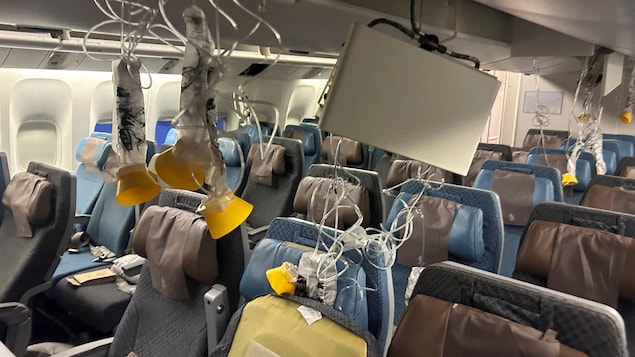- Home
- International
Climate change is making turbulence worse, although deaths are still rare, experts say
1 person died Tuesday on a Singapore Airlines flight that experienced severe turbulence

The interior of Singapore Airlines flight SQ321 is pictured after an emergency landing at Bangkok's Suvarnabhumi International Airport on Tuesday. (Reuters)
Photo: Reuters / Stringer
Natalie Stechyson (new window) · CBC News
Most people who have flown have likely felt their stomach drop when the "fasten seatbelt" sign switches on during a bumpy flight, but turbulence can be severe and experts warn it's becoming more common.
Turbulence fatalities on commercial flights are fortunately very rare, but have sadly increased by one today,
Paul Williams, a professor of atmospheric science at the University of Reading, U.K., told CBC News in an email interview.
On Tuesday, one passenger was killed and 30 were injured after a Singapore Airlines flight from London hit severe turbulence (new window) en route, forcing it to make an emergency landing in Bangkok, officials and the airline said. A passenger on board the flight told Reuters the plane dropped dramatically, launching everyone not wearing a seatbelt into the ceiling.
A 73-year-old British man died during the incident, likely due to a heart attack, Suvarnabhumi airport general manager Kittipong Kittikachorn told a news conference. Seven people were critically injured with head injuries.
Turbulence — a sudden, violent shift in air flow — is the most common cause of airline accidents involving injuries, according to a 2021 study by the National Transportation Safety Board (new window) (NTSB). From 2009 through 2018, the U.S. agency found that turbulence accounted for more than a third of reported airline accidents and most resulted in one or more serious injuries.
And it's likely only going to get worse due to climate change, climate (new window) and aviation (new window)experts have noted. There is strong evidence that turbulence is increasing because of climate change, Williams said, citing his own research (new window) that severe clear-air turbulence in the North Atlantic has increased by 55 per cent since 1979.

AskThePilot.com, FlyingWithConfidence.com
Photo: CBC
Our latest future projections indicate a doubling or tripling of severe turbulence in the jet streams in the coming decades, if the climate continues to change as we expect,
he said.
Turbulence on flights can be caused by storms, mountains and strong air currents called jet streams, Williams noted. But the type of turbulence likely involved in today's accident is called clear-air turbulence, he said.
It can be difficult to avoid because it doesn't show up on the weather radar in the flight deck. A detailed analysis of the meteorological circumstances and the particular type of turbulence that caused today's fatality will take some time,
Williams said.
- Passenger dead, 30 injured as Singapore Airlines flight hits severe turbulence, officials say (new window)
- Climate change is making flights more turbulent, meteorologist says. Here's what to do about it (new window)
Other recent research published in Nature Climate Change (new window) shows climate change is distorting the jet stream (new window), making the powerful winds in the upper atmosphere even faster.
Based on these results and our current understanding, we expect record-breaking winds,
Tiffany Shaw, a professor of geophysical sciences at the University of Chicago, said in a news release (new window) last year.
And it's likely that they will feed into decreased flight times, increased clear-air turbulence and a potential increase in severe weather occurrence.
56 incidents in Canada
Since 2015, there have been 56 incidents with turbulence-related injuries reported to the Transportation Safety Board of Canada, a spokesperson told CBC News.
Of those, nine involved serious injuries, and there were no deaths, the TSB said. Two of the incidents led to investigations. One was a 2015 Air Canada flight (new window)from China that resulted in injuries to 21 passengers. Many passengers were not wearing seatbelts (new window) at the time, the TSB report noted.
- Turbulence on U.S. flight sent some flying into aircraft ceiling, passengers say (new window)
- 37 hurt, 9 seriously, on Air Canada flight hit by turbulence (new window)
The other investigation involved a 2022 crash (new window) near Sioux Lookout, Ont., in which the two people aboard a Cessna 208 Caravan aircraft were injured.
In 2019, 37 people aboard an Air Canada flight from Vancouver to Sydney were injured due to severe turbulence (new window).
WATCH | Why turbulence is getting worse:
In the U.S., there have been 163 cases of serious turbulence injuries between 2009 and 2022, according to the Federal Aviation Administration. (new window) Of those, 129 cases involved flight crew and only 34 involved passengers. The NTSB report noted that's because flight attendants are frequently required to be up and about without the safety benefit of a seatbelt.
The last turbulence death on a commercial flight was in 2009, Williams said, and the last death caused by clear-air turbulence on a commercial flight was in 1997, on a United Airlines flight from Tokyo to Honolulu.

Emergency personnel and airport staff stand near the plane after it made an emergency landing at Suvarnabhumi airport in Bangkok.
Photo: Reuters / Pongsakornr Rodphai
Boeing 777 pilot Shem Malmquist, a visiting instructor at the Florida Institute of Technology and Fellow of the Royal Aeronautical Society, told CBC News that injuries related to turbulence aren't as rare as they used to be as climate change is increasing the strength of storms.
With climate change, we get warmer oceans, which increases the probability for storms to manifest in this way that pilots just have not been trained, in general to detect,
he said.
Lately, we're seeing incidents where people are injured by turbulence somewhere in the world every few weeks, he added.
And I think that we can see an increased number of them as the Earth continues to increase the average temperatures. It's just basic physics.
WATCH | Some passengers were carried off in stretchers:
ABOUT THE AUTHOR
Natalie Stechyson (new window) · Senior writer and editor
Natalie Stechyson is a senior writer and editor at CBC News. She's worked in newsrooms across the country, including the Globe and Mail, Postmedia News, Calgary Herald and Brunswick News. Before joining CBC News, she was the Parents editor at HuffPost Canada, where she won a silver Canadian Online Publishing Award.
With files from Reuters, and CBC's Briar Stewart




